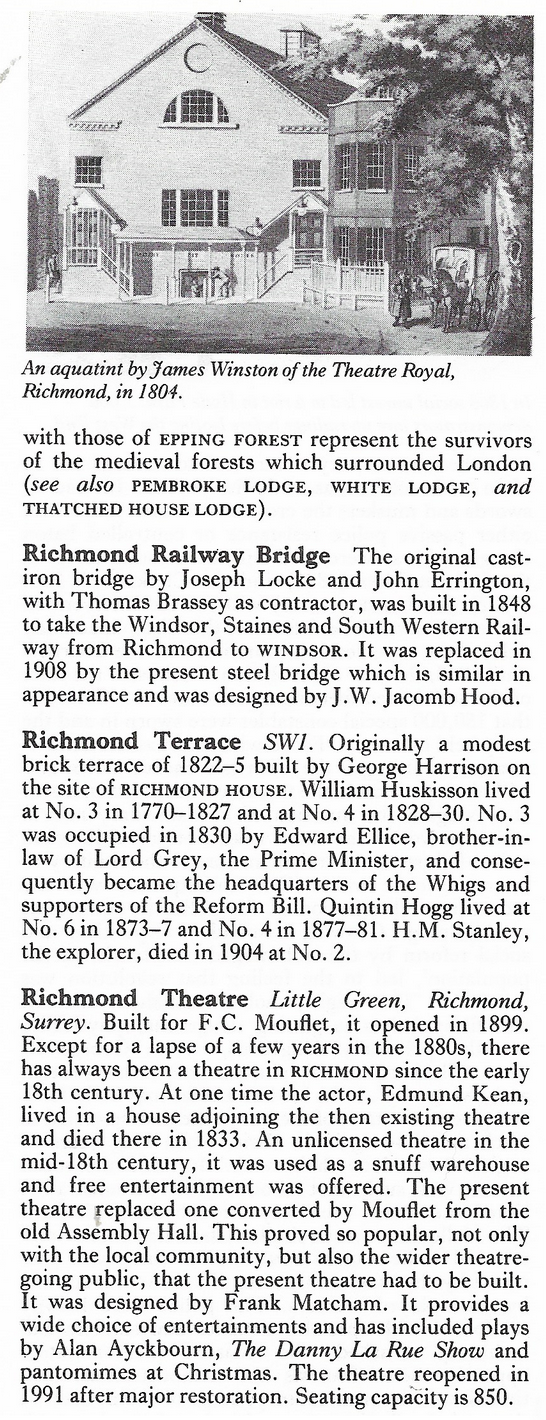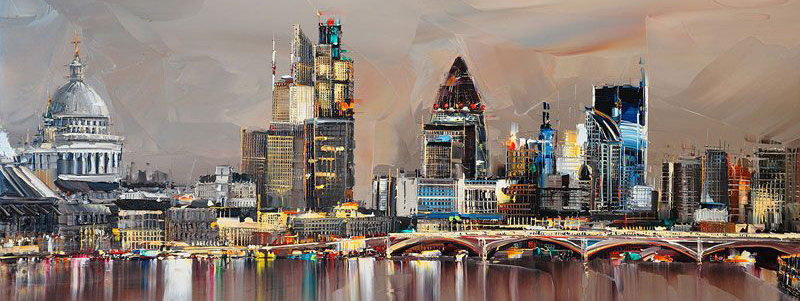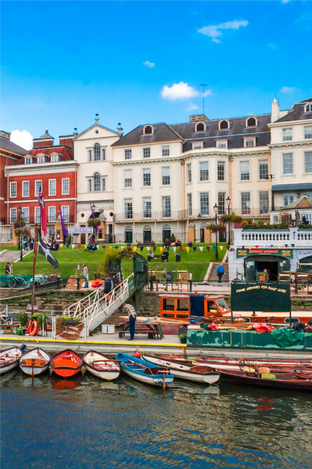 Richmond encompasses an area of about fourteen thousand acres and owes its name to the presence of a namesake palace from the 18th century. In the Sixth Century, the area was known as Sheen, and a royal residence had previously stood there, which was destroyed by a fire in 1497. The Queens Mary and Elizabeth I, along with King Charles I, resided at Richmond Palace, which was subsequently demolished. Some parts have survived, including the so-called Wardrobe, converted into housing, and the Trumpeters' House, named such for the statues of two trumpeters that adorned one of the gates of the old palace. The new two-story palace was constructed in 1708, its main facade, supported by Doric columns, facing Cholmondeley Walk. Richmond's territory stretches for miles along both banks of the Thames. Although the two main streets, George Street and Hill Street, are choked with traffic, many pleasant side streets branch off in all directions. Richmond is one of the greenest districts, hosting around fifteen thousand trees, many of which are centuries old. It boasts numerous luxury shops, historic pubs, and secluded, peaceful cafes. For those interested in art, there is the Riverside Gallery, located in the Old Town Hall, with its permanent exhibition of items related to local history. Every Saturday, there is a market where farmers and breeders sell vegetables, cheese, meat, and bakery products. During peak hours, there is a train service between Richmond and North Woolwich, a very long route, marked on the map only by thin lines. From Richmond, the train climbs to Hampstead, then descends back towards the Thames, crossing the entire East End. It is a journey that allows one to see city corners that would otherwise remain hidden, especially in those stretches where the line runs above ground. On Arsenal match days, the carriages are filled with fans.
Richmond encompasses an area of about fourteen thousand acres and owes its name to the presence of a namesake palace from the 18th century. In the Sixth Century, the area was known as Sheen, and a royal residence had previously stood there, which was destroyed by a fire in 1497. The Queens Mary and Elizabeth I, along with King Charles I, resided at Richmond Palace, which was subsequently demolished. Some parts have survived, including the so-called Wardrobe, converted into housing, and the Trumpeters' House, named such for the statues of two trumpeters that adorned one of the gates of the old palace. The new two-story palace was constructed in 1708, its main facade, supported by Doric columns, facing Cholmondeley Walk. Richmond's territory stretches for miles along both banks of the Thames. Although the two main streets, George Street and Hill Street, are choked with traffic, many pleasant side streets branch off in all directions. Richmond is one of the greenest districts, hosting around fifteen thousand trees, many of which are centuries old. It boasts numerous luxury shops, historic pubs, and secluded, peaceful cafes. For those interested in art, there is the Riverside Gallery, located in the Old Town Hall, with its permanent exhibition of items related to local history. Every Saturday, there is a market where farmers and breeders sell vegetables, cheese, meat, and bakery products. During peak hours, there is a train service between Richmond and North Woolwich, a very long route, marked on the map only by thin lines. From Richmond, the train climbs to Hampstead, then descends back towards the Thames, crossing the entire East End. It is a journey that allows one to see city corners that would otherwise remain hidden, especially in those stretches where the line runs above ground. On Arsenal match days, the carriages are filled with fans.A WALK ALONG THE THAMES...
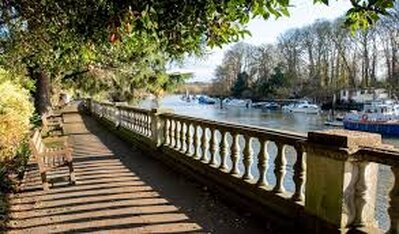 The river is one of the major attractions of the area. Along its banks are many pedestrian paths, jogging routes, and cycling tracks that follow the river's winding curves. The possibilities are vast. Starting from Richmond Bridge, which is conveniently close to the metro and train stations, one can head north along Riverside, facing Corporation Island, then continue along Cholmondeley towards Old Deer Park, passing Richmond Lock, up to Isleworth Ait. Alternatively, one might venture south towards the Bucoleuch Gardens and Petersham Meadows, with Glover's Island just in front, towards the Ferry Foot beneath Richmond Hill—a stretch known as Horse Reach, with Glover's Island in view and across the velvety fields of Petersham Meadows.
The river is one of the major attractions of the area. Along its banks are many pedestrian paths, jogging routes, and cycling tracks that follow the river's winding curves. The possibilities are vast. Starting from Richmond Bridge, which is conveniently close to the metro and train stations, one can head north along Riverside, facing Corporation Island, then continue along Cholmondeley towards Old Deer Park, passing Richmond Lock, up to Isleworth Ait. Alternatively, one might venture south towards the Bucoleuch Gardens and Petersham Meadows, with Glover's Island just in front, towards the Ferry Foot beneath Richmond Hill—a stretch known as Horse Reach, with Glover's Island in view and across the velvety fields of Petersham Meadows.Along the pedestrian path, elegant residences alternate with pubs, and rows of houses give way to green spaces and lanes.
For those wishing to take advantage of rowboat rentals for a stint on the water, this is the place to be. Otherwise, one can embark on a lengthy boat tour, bearing in mind that departures are hourly.
Tide Management Device - Since Richmond is subject to tides, directly after Twickenham Bridge there is a hydraulic device intended to protect its banks. This light-coloured contraption of late Victorian era combines several elements with different functions. There is a lock and a pedestrian bridge over three massive castellations that support very wide sluice gates. When the tide ebbs, the gates are lowered into the grooves with a thud, and as the water level rises, they are lifted. This occurs twice daily. For more information, one can call Harbour Services.
Returning towards Richmond Bridge, at the end of a walk or boat trip, one can refresh themselves in one of the numerous pubs and restaurants.
...OR GO FOR A STROLL ON THE GREEN
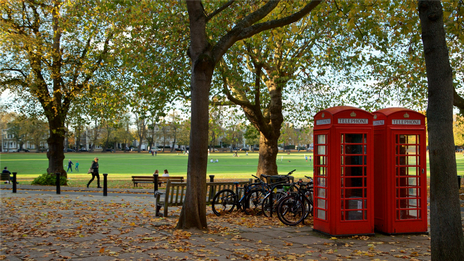
The Green is a vast, square-shaped green space that has remained unchanged over time; in summer, it is crowded with people walking and sunbathing. It is flanked by beautiful, elegant houses both along Portland Terrace to the northeast and Pembroke Villas to the northwest, where there are ten semi-detached homes built in 1840, on the site of Lord Fitzwilliam's palace, which had housed his vast collection of ancient objects and works of art, and now forms the core of the Fitzwilliam Museum in Cambridge. The elegant Old Palace Lane, leading down to Twickenham Bridge, and the Old Gate House exude an Old England atmosphere, making them delightful places for a stroll. With its early nineteenth-century houses, Old Palace Lane epitomizes England's past. From here, one can continue to Cholmondeley Walk, which follows the riverbank, pass the round building marking the entrance to the tunnel beneath the river, reach Richmond Lock, constructed in 1894, offering splendid river views, and arrive at Asgill House. Archery tournaments have been held on the Green since the 1600s. Later, it also became a venue for cricket matches, the first recorded one taking place in 1730 between a Surrey team and one from Middlesex. After the matches, the players would visit The Cricketers pub, still in existence today. However, the current building dates back to 1844, as the previous one was destroyed by a fire. Autumn is the most picturesque time to visit, with its fabulous colors.
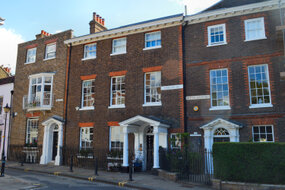 Just below the Green, on King Street, stands Oak House, located on the site where the Observant branch had their monastery until the dissolution of the monastic orders. Later known as the Order of Friars Minor, they were the most ascetic and strict branch of the Franciscan family, living lives of great poverty, prayer, and penance. The dark-brick Oak House was possibly built by Robert Taylor around 1760. Nearby, in Friars Lane, another building named Old Friars bears the date 1687 under its cornice.
Just below the Green, on King Street, stands Oak House, located on the site where the Observant branch had their monastery until the dissolution of the monastic orders. Later known as the Order of Friars Minor, they were the most ascetic and strict branch of the Franciscan family, living lives of great poverty, prayer, and penance. The dark-brick Oak House was possibly built by Robert Taylor around 1760. Nearby, in Friars Lane, another building named Old Friars bears the date 1687 under its cornice.THEATRE ON THE GREEN
LITTLE GREEN,
UNDERGROUND STATION: RICHMOND
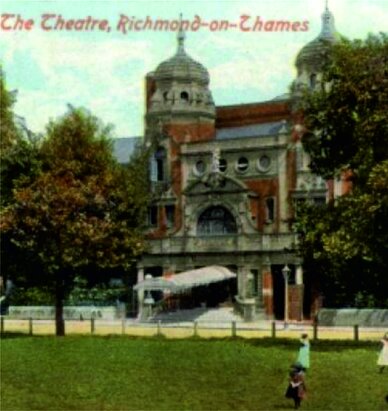 The Victorian building housing Richmond Theatre is a magnificent structure designed by architect Frank Matcham. Its terracotta decorations and copper domes at the facade corners reflect the taste of that era. This is also true for the interior's intricate gold leaf and red velvets. It opened on September 18, 1899, with Shakespeare's comedy As You Like It as the inaugural performance. Today, it hosts weekly drama and musical performances by prominent touring companies. A traditional pantomime is featured at Christmas and New Year. The Theatre on the Green has appeared in many films, including Finding Neverland and The Hours. Richmond also boasts another theatre, the Orange Tree Theatre, known for its central stage and national reputation for quality productions.
The Victorian building housing Richmond Theatre is a magnificent structure designed by architect Frank Matcham. Its terracotta decorations and copper domes at the facade corners reflect the taste of that era. This is also true for the interior's intricate gold leaf and red velvets. It opened on September 18, 1899, with Shakespeare's comedy As You Like It as the inaugural performance. Today, it hosts weekly drama and musical performances by prominent touring companies. A traditional pantomime is featured at Christmas and New Year. The Theatre on the Green has appeared in many films, including Finding Neverland and The Hours. Richmond also boasts another theatre, the Orange Tree Theatre, known for its central stage and national reputation for quality productions. The hall of the pub, now called Roebuck, located opposite the train station, was a significant meeting place for rock musicians, with performances by the Rolling Stones among others.
THE MAIDS OF HONOUR ROW
UNDERGROUND STATION: RICHMOND
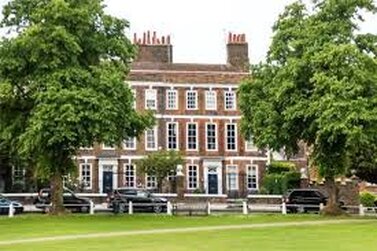 The Maids of Honour Row, dedicated to the queen's maids of honour, features four well-preserved three-story houses built in 1724. They were constructed by order of the soon-to-be-king George II. When his wife, the Princess of Wales, was at Richmond Lodge, her maids of honour would lodge here.
The Maids of Honour Row, dedicated to the queen's maids of honour, features four well-preserved three-story houses built in 1724. They were constructed by order of the soon-to-be-king George II. When his wife, the Princess of Wales, was at Richmond Lodge, her maids of honour would lodge here.The houses have simple but well-proportioned facades, with Roman columns at the entrances and delicate wrought iron gates. And speaking of maids of honour, a century earlier, courtier John Harington had been banished by the queen because, according to her, he had corrupted their minds with his writings. Harington was an author of epigrams and had also translated the story of Giocondo into English, as told in Ariosto's Orlando Furioso. The British explorer Richard Burton lived at number 2. In 1744, number 4 became the home of John James Heidegger, manager of the King's Theatre in Haymarket. The entrance was adorned with landscapes executed by Antonio Joli, who was his scene painter.
ASGILL HOUSE
29 OLD PALACE LANE,
UNDERGROUND STOP: RICHMOND
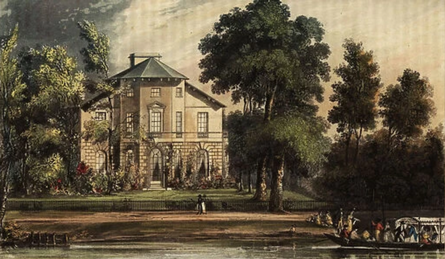 The house, which stands next to the river, was built in 1760 for Sir Charles Asgill, a shrewd merchant who later became the Mayor of London. The architect was Robert Taylor, founder of the Taylorian Institute. Asgill House is the smallest villa designed by Taylor. From its curious octagonal room, there is a beautiful view of the river, the islet, and the yards where small boats are repaired. Beyond are the gardens of Trumpeter's House and Queensberry House. In the nearby Water Lane, goods were once transferred in and out via the river, and it was an area prone to flooding. Walking along it today and continuing on to Petersham Road leads to the beautiful park of Terrace Gardens, from which point the ascent up Richmond Hill begins. What has since become the Old Vicarage School was once the residence of the Houblon sisters. To stop the hustle and bustle that had developed in the area, the two sisters had purchased and then closed the therapeutic water wells that were located right in front of their house.
The house, which stands next to the river, was built in 1760 for Sir Charles Asgill, a shrewd merchant who later became the Mayor of London. The architect was Robert Taylor, founder of the Taylorian Institute. Asgill House is the smallest villa designed by Taylor. From its curious octagonal room, there is a beautiful view of the river, the islet, and the yards where small boats are repaired. Beyond are the gardens of Trumpeter's House and Queensberry House. In the nearby Water Lane, goods were once transferred in and out via the river, and it was an area prone to flooding. Walking along it today and continuing on to Petersham Road leads to the beautiful park of Terrace Gardens, from which point the ascent up Richmond Hill begins. What has since become the Old Vicarage School was once the residence of the Houblon sisters. To stop the hustle and bustle that had developed in the area, the two sisters had purchased and then closed the therapeutic water wells that were located right in front of their house. RICHMOND BRIDGE, THE LOCK AND THE PEDESTRIAN BRIDGE
BRIDGE STREET
UNDERGROUND STOP: RICHMOND
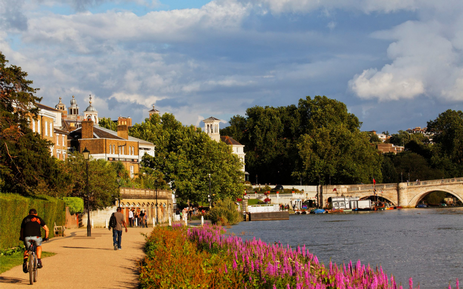 The beautiful Richmond Bridge was built in 1777 with Portland stone. It was intended to replace the passenger boats and ferries for carts and today is the oldest on the river.
The beautiful Richmond Bridge was built in 1777 with Portland stone. It was intended to replace the passenger boats and ferries for carts and today is the oldest on the river.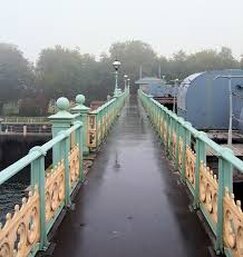 However, the Victorian lamps were retained, and converted from gas to electric power. In 1977, its two-hundredth anniversary was celebrated. The bridge has been immortalized in the paintings of Constable and Turner.
However, the Victorian lamps were retained, and converted from gas to electric power. In 1977, its two-hundredth anniversary was celebrated. The bridge has been immortalized in the paintings of Constable and Turner. Once along the riverbank at this point, fishermen would set up their rods. Where the lock is located, there is also a pedestrian bridge, accessible by steps; near the pavilion with a metal roof, there stands a clock used for calculating the tide hours. It is one of the support points of the Port of London Authority offices.
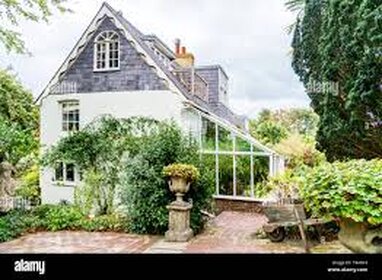 In this modest house with dark brick facade, between 1915 and 1924, Virginia and Leonard Woolf lived. The Georgian-style building was constructed in 1748 on the land east of the church and the Green. The Woolfs occupied half of the house, and during German air raids, Virginia slept in the basement.
In this modest house with dark brick facade, between 1915 and 1924, Virginia and Leonard Woolf lived. The Georgian-style building was constructed in 1748 on the land east of the church and the Green. The Woolfs occupied half of the house, and during German air raids, Virginia slept in the basement. 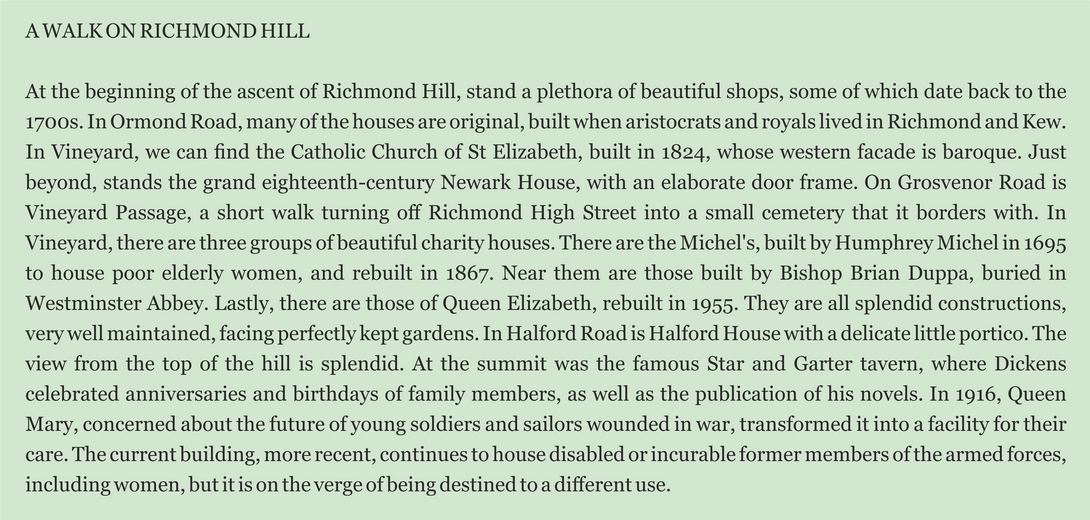
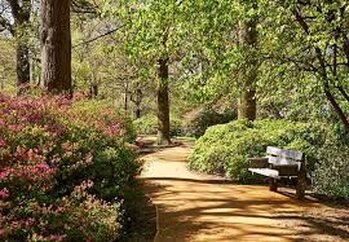 Richmond Park is both a nature reserve and a site of scientific interest. Its nearly ten square kilometers were enclosed in 1637 by Charles I, who used to come here for hunting. Local residents had the right of way. It is the largest of the royal parks and is famous for its herds of red deer roaming freely. At feeding time, they can be seen following the truck that brings their forage. There are also woodpeckers, squirrels, and ring-necked parakeets. In the southwest corner of the park is Isabella Plantation, an enchanting wooded area with ponds and streams.
Richmond Park is both a nature reserve and a site of scientific interest. Its nearly ten square kilometers were enclosed in 1637 by Charles I, who used to come here for hunting. Local residents had the right of way. It is the largest of the royal parks and is famous for its herds of red deer roaming freely. At feeding time, they can be seen following the truck that brings their forage. There are also woodpeckers, squirrels, and ring-necked parakeets. In the southwest corner of the park is Isabella Plantation, an enchanting wooded area with ponds and streams.
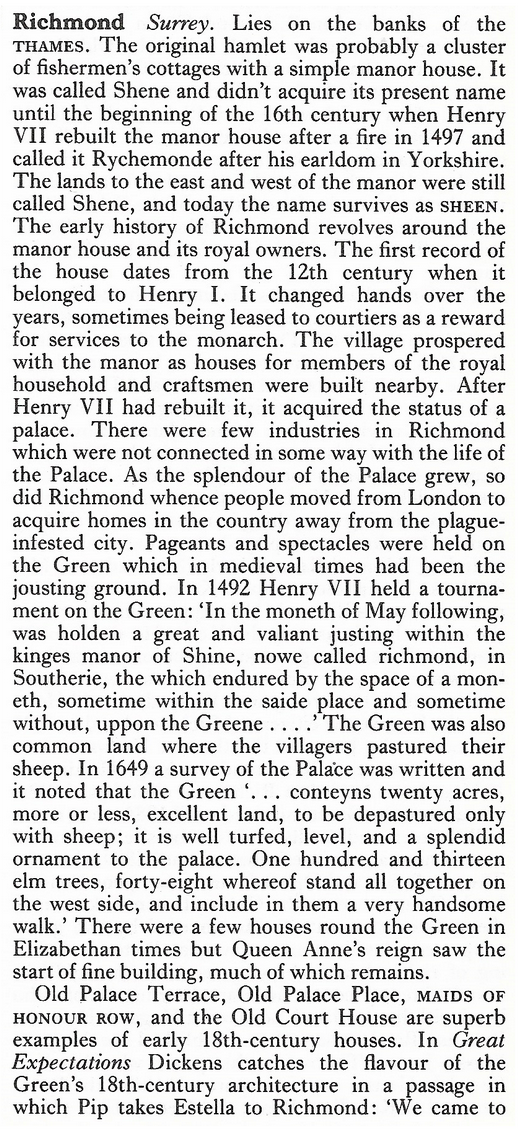
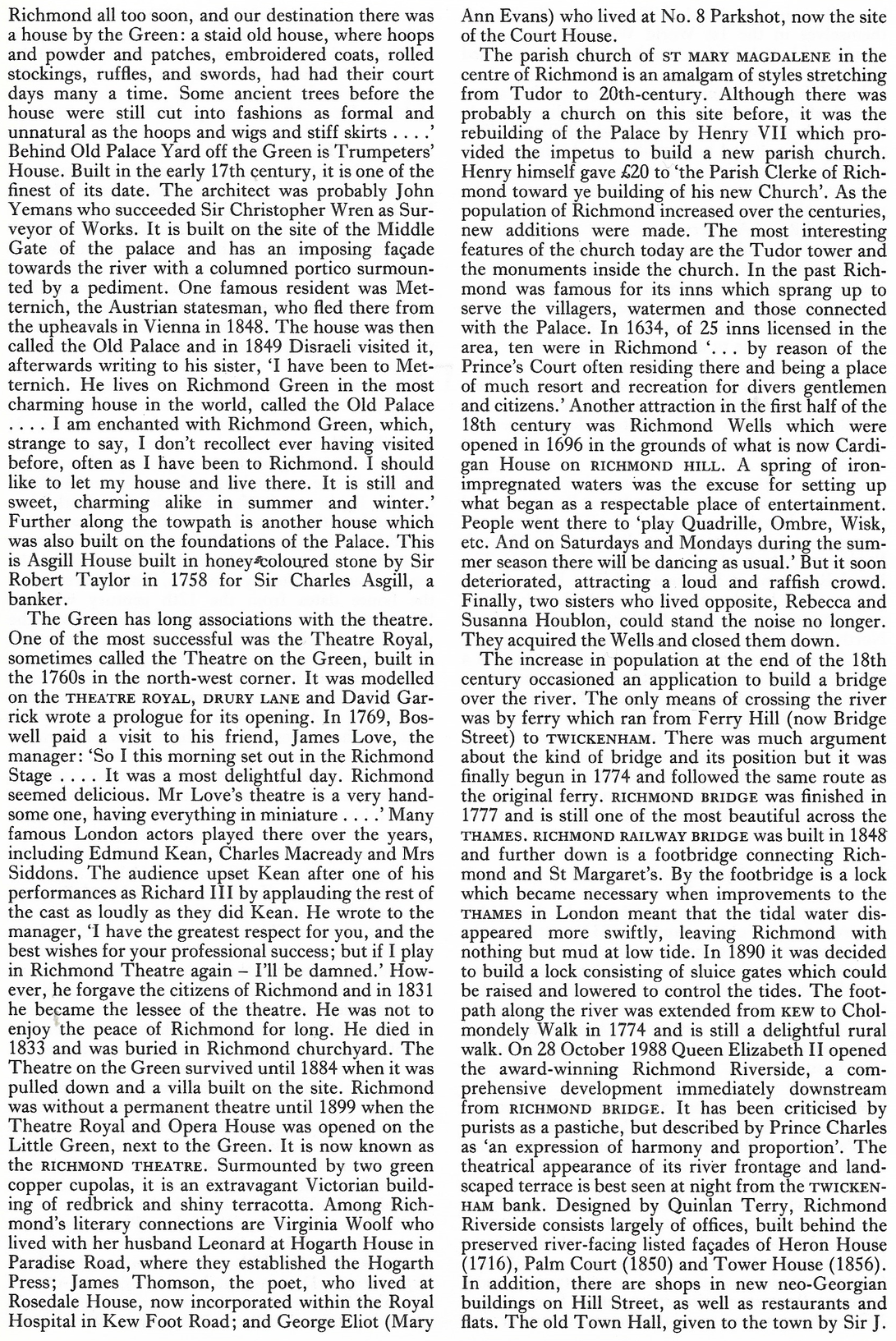
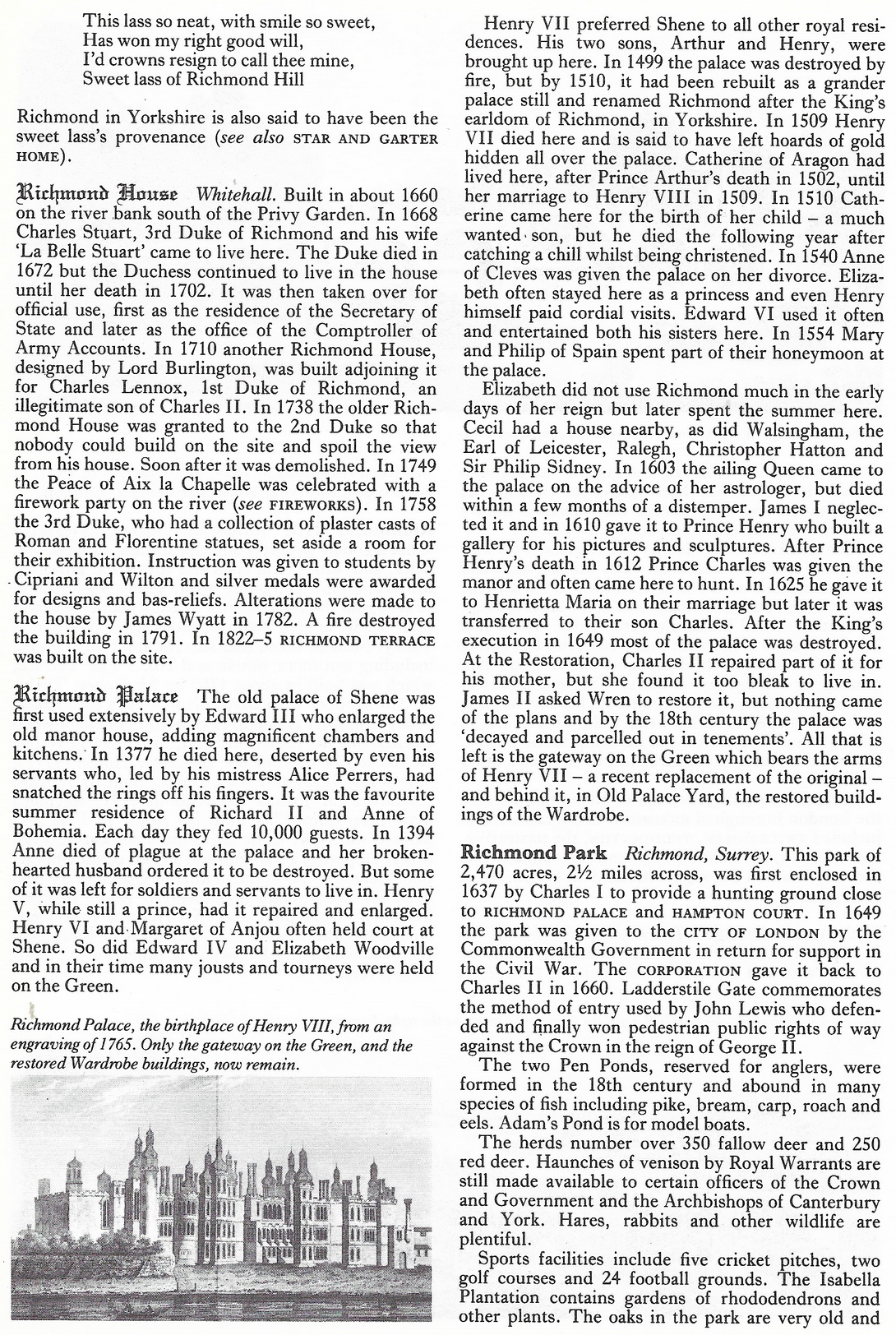
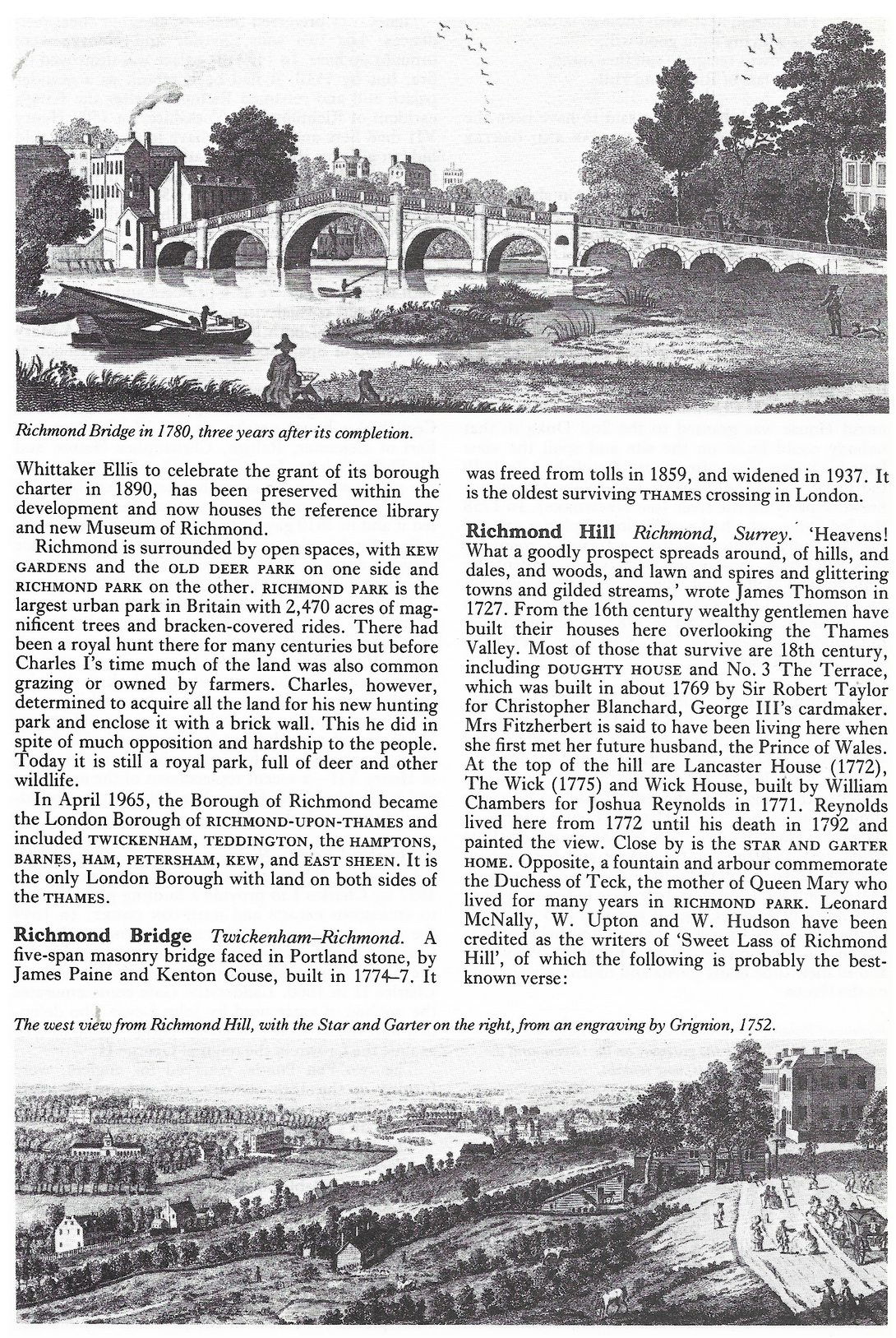
MONK'S HOUSE AND VIRGINIA WOOLF
17 PARADISE ROAD,
UNDERGROUND STOP: RICHMOND
 In this modest house with dark brick facade, between 1915 and 1924, Virginia and Leonard Woolf lived. The Georgian-style building was constructed in 1748 on the land east of the church and the Green. The Woolfs occupied half of the house, and during German air raids, Virginia slept in the basement.
In this modest house with dark brick facade, between 1915 and 1924, Virginia and Leonard Woolf lived. The Georgian-style building was constructed in 1748 on the land east of the church and the Green. The Woolfs occupied half of the house, and during German air raids, Virginia slept in the basement. One of the house's rear windows overlooked the Kew Gardens, where Virginia often went for walks and where she set one of her stories. Leonard Woolf, in his autobiography titled Beginning Again from 1964, recounts some episodes that occurred here during their stay. When they moved here, Virginia had finished writing The Voyage Out and was in a state of physical and nervous exhaustion. In September 1913 she attempted suicide, and in 1915 she had a relapse of her depression. Her husband sought a residence with an occupation that could engage her interest and bring her relief. The printing activity, set in Hogart's house, was initially amateur, then became more professional, and about thirty books were printed. Texts by members of the Bloomsbury Group were published, along with volumes on psychoanalysis and translations of foreign books, like those of Russian fiction.
If you fancy a cup of tea - the selection is vast – or wish to eat a sandwich, a scone, or another sweet treat, you can go to Tea Box at number 7 on this street, on the corner, which is a lovely tea room with a very intimate interior. There are also poetry and reading evenings and small art exhibitions.

TERRACE GARDENS
2 SPRING GARDENS,
UNDERGROUND STOP: RICHMOND
The park, located between Richmond Hill to the east and Petersham Road to the west, was opened to the public in 1887. It is flanked by beautiful Georgian houses and others from the 19th century, some of which have been converted into hotels. Below are the tree-lined banks of the Thames, whose waters, still as silver, appear as in the time of Walter Scott, who described them in a scene from The Heart of Midlothian. Artists as diverse as Turner and Oskar Kokoschka have ascended to Terrace Gardens to paint the panorama and the river as seen from here. In the park, there is a statue of the Thames by John Bacon in Coade stone and another of Aphrodite by Allan Howes, executed in 1952. Wick House was built by Sir William Chambers for Sir Joshua Reynolds.
RICHMOND PARK
QUEEN'S ROAD,
UNDERGROUND STOP: RICHMOND
 Richmond Park is both a nature reserve and a site of scientific interest. Its nearly ten square kilometers were enclosed in 1637 by Charles I, who used to come here for hunting. Local residents had the right of way. It is the largest of the royal parks and is famous for its herds of red deer roaming freely. At feeding time, they can be seen following the truck that brings their forage. There are also woodpeckers, squirrels, and ring-necked parakeets. In the southwest corner of the park is Isabella Plantation, an enchanting wooded area with ponds and streams.
Richmond Park is both a nature reserve and a site of scientific interest. Its nearly ten square kilometers were enclosed in 1637 by Charles I, who used to come here for hunting. Local residents had the right of way. It is the largest of the royal parks and is famous for its herds of red deer roaming freely. At feeding time, they can be seen following the truck that brings their forage. There are also woodpeckers, squirrels, and ring-necked parakeets. In the southwest corner of the park is Isabella Plantation, an enchanting wooded area with ponds and streams.The grove was created in the 1950s and today, at any time of the year, there is always some exotic plant in bloom or a shrub full of colors. Among the trees, many of which are centuries-old oaks, live many birds, including the melodious red-headed finches, bullfinches, sparrowhawks, and the beautiful owls. From Richmond station, one must take bus 65 to Ham Common, then walk along Ham Gate Avenue.
Another attraction is the Queen Mother's Copse, a flowering thicket in the woods created in memory of the Queen Mother. In the park area, there are several buildings of notable architecture. One of these is Pembroke Lodge, built for the first Duke of Russell, which now houses a famous restaurant. Pembroke Lodge was also the residence of Prime Minister John Russell and his nephew, the writer and pacifist Bertrand Russell. The garden of this residence is built around the highest point of the park, known as Henry VIII Mound. From the telescope installed here, there is a magnificent view of the City and St Paul's Cathedral, while to the west, the view is over the Thames Valley. Another important building, home to the Royal Ballet School, is the White Lodge. In the southwest corner near Kingston Gate, there is a terreplein, which once held an ice house beneath it. On it stands Thatched Lodge, a summer residence decorated with paintings in the style of Angelika Kauffmann. In Palewell Park, adjacent to Richmond Park, there is a smaller golf course, with only nine holes, in the extraordinary landscape of Beverley Brook, where the green is meticulously maintained. For those who wish to take lessons, there is a teacher available, and, compared to regular courses, this one can be approached without too much hassle.
By bike or on horseback - In the park, you can also cycle, provided you do not exceed a speed of twenty miles. Of course, you can go horseback riding and you can also bring dogs, which, however, must not disturb or harm wildlife. Radios or musical instruments are not allowed.
Richmond Upon Thames
The London Encyclopaedia




